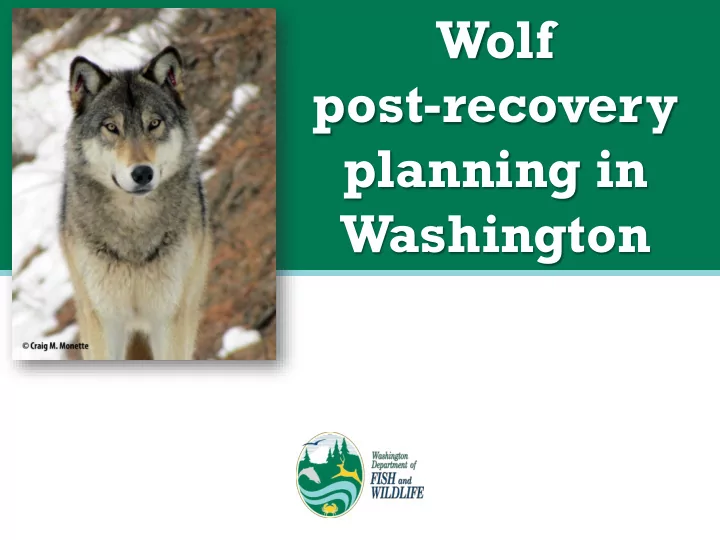

Wolf post-recovery planning in Washington
Washington wolf history 1930s: Extirpated from WA 1973: Receive federal protection 1980: Wolves receive state protection 2008: First resident pack documented in Okanogan County 2011: Federally delisted in eastern third of WA (part of Northern Rocky Mt Distinct Population Segment) 2011: WA Wolf Conservation and Management Plan adopted 2013: Wolf Advisory Group formed 2018: Min. 126 wolves, 27 packs, 15 breeding pairs in WA Department of Fish and Wildlife
Wolves are returning to and recovering in Washington Department of Fish and Wildlife
Washington’s wolf ~1,700 wolves population is connected to and part of the larger, healthy wolf populations in Idaho, Montana, Wyoming, Oregon, and Canada. Department of Fish and Wildlife
2018 Washington Wolf Packs Department of Fish and Wildlife Department of Fish and Wildlife
Washington Wolf Plan Objectives 1. Restore self-sustaining wolf populations 2. Maintain healthy ungulate populations 3. Manage wolf – livestock conflicts 4. Develop public understanding and promote coexistence Department of Fish and Wildlife
1. Restore self-sustaining wolf populations Assessing statewide recovery 15 successful breeding pairs for three consecutive years, OR 18 successful breeding pairs for one year, WITH At least four breeding pairs in each recovery region and six pairs anywhere in WA No known packs or breeding pairs in Southern Cascades/NW Coast region Federal listing status Department of Fish and Wildlife
1. Restore self-sustaining wolf populations Assessing statewide recovery WAC 220-610-110 WAC language: a species may be delisted from endangered, threatened, or sensitive when it meets the recovery plan goals or when it is no longer in danger of failing, declining, is no longer vulnerable to factors such as limited numbers, disease, predation, exploitation, or habitat loss or change, and when it no longer meets the definitions of Sensitive, Threatened, or Endangered Periodic Status Review will evaluate these factors If a change in listing status is recommended, this would initiate a public engagement/Commission process (no earlier than 2020) Department of Fish and Wildlife
1. Restore self-sustaining wolf populations Annual population counts 140 126 130 122 115 120 110 Min. number individuals 100 90 90 80 68 70 60 52 51 50 35 40 30 19 20 14 5 10 0 2008 2009 2010 2011 2012 2013 2014 2015 2016 2017 2018 Department of Fish and Wildlife
1. Restore self-sustaining wolf populations Trend in number of wolf packs 25 22 20 19 Min. number of packs 17 15 15 13 10 10 7 5 5 5 3 3 3 3 3 2 2 2 1 1 1 1 0 2008 2009 2010 2011 2012 2013 2014 2015 2016 2017 2018 E Washington N Cascades S Cascades and NW Coast Department of Fish and Wildlife
1. Restore self-sustaining wolf populations Trend in number of successful breeding pairs 14 13 12 12 10 Min. known number 8 8 7 6 4 4 4 4 3 3 2 2 2 1 1 1 1 1 1 1 1 1 0 2008 2009 2010 2011 2012 2013 2014 2015 2016 2017 2018 E Washington N Cascades S Cascades and NW Coast Department of Fish and Wildlife
1. Restore self-sustaining wolf populations Washington Wolf Population Summary Year Min. count Known no. packs SBP Growth rate Known Depredating mortality packs (%) 2008 5 1 1 -- 0 0% 2009 14 2 2 -- 0 0% 2010 19 3 1 36% 2 0% 2011 35 7 5 84% 0 0% 2012 51 9 5 46% 9 33% 2013 52 13 5 2% 5 8% 2014 68 16 5 31% 10 13% 2015 90 18 8 32% 7 22% 2016 115 20 10 28% 14 20% 2017 122 22 14 6% 14 23% 2018 126 27 15 3% 12 19% Avg 28% 13% Department of Fish and Wildlife
Wolf post-recovery planning What is a post-recovery plan? Doesn’t WDFW already have a wolf plan? Why does WDFW need to develop a new wolf plan now? How will WDFW develop a wolf post-recovery plan? Photo: Tom Meier, NPS Department of Fish and Wildlife
What is scoping? State Environmental Policy Act (SEPA) Environmental Impact Statement (EIS) First step of a multi-year SEPA process Range of proposed actions, alternatives, and impacts to be discussed in EIS Narrow EIS to the relevant/significant issues Encourage cooperation and early resolution of conflicts and improve decisions Department of Fish and Wildlife
Initial impact topics to be considered in EIS Wolf conservation and monitoring Wolf management areas Wolf classification/status Wolf-livestock conflicts Wolf-ungulate interactions Wolf interactions with other species Wolf-human interactions Cultural and/or tribal significance of wolves Ecotourism/intrinsic value Wolf hunting Habitat connectivity/land management Information and education Research Reporting and evaluation Goals, objectives, strategies, tasks Costs and funding priorities Economic analysis Translocation Department of Fish and Wildlife Photo: Julia B. Smith
How to provide comment 1. Submit comments electronically at: wdfw.wa.gov/wolves-post-recovery (preferred method) 2. Mail comments to: Lisa Wood SEPA/NEPA Coordinator, WDFW Habitat Program, Protection Division P.O. Box 43200, Olympia, WA 98504-3200 Please submit comments by November 1, 2019 at 5 pm . We cannot accept or record verbal comments. Department of Fish and Wildlife
Stay up to date by visiting WDFW .WA.GOV/WOLVES-POST-RECOVERY For general information on wolves in Washington: https://wdfw.wa.gov/species- habitats/at-risk/species-recovery/gray- wolf If you are interested in receiving e-mail notifications of wolf activity updates, you can sign up here: https://wdfw.wa.gov/about/lists Department of Fish and Wildlife
Thank you! Questions? wildthing@dfw.wa.gov Department of Fish and Wildlife
Recommend
More recommend